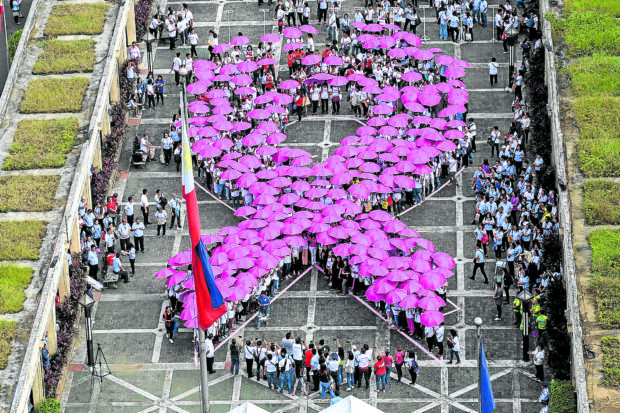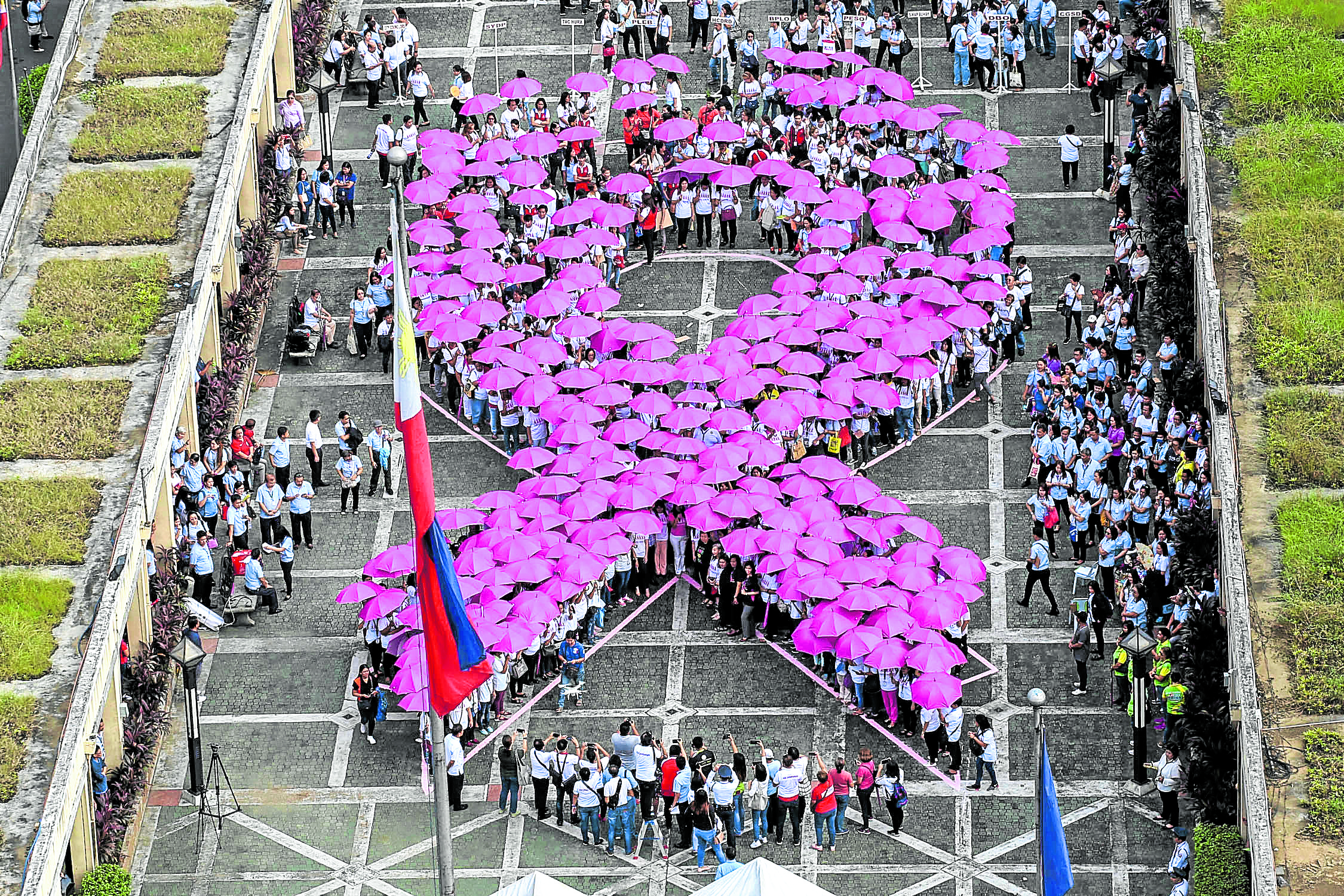
“Buhok mo na yan, Ma’am?”
Here we go again, I mutter under my breath.
“Hindi ako nag-chemo, Emily,” I tell my surgeon’s secretary. I see her every couple of months, and she asks me the same thing.
Can’t blame her. She has just seen too many patients come through her boss’ door with their heads wrapped in bandannas for months on end, such that a patient with a full head of hair (chemically colored, at that) was probably always a welcome sight.
In 2017, at this time of year, I was diagnosed with stage IIA breast cancer. “Invasive ductal carcinoma with lobular features,” the most common type, Dr. Felina Cruz, my surgeon at Makati Medical Center (MMC), told me.
I never imagined I would get cancer. No one had ever been sick of cancer in my family. In moments of hypochondria, I feared I would drop dead of a brain aneurysm or a stroke, hypertension being a family disease.
But cancer? Not a chance. That’s why I had never felt the need for a mammogram, until I accidentally found that lump under my right breast.
In my 42 years, it was the first time I had ever performed a breast self-exam, after watching a rather poorly made how-to video that appeared on my Facebook feed. (I’m grateful every day to the bra company that made it!) It was All Souls’ Day weekend, and remnants of Breast Cancer Awareness campaigns from October were still popping up on my social media.
Second opinion
I recall going to several other oncologists in other hospitals for a “second opinion,” an exercise that would become the root of my anxiety.
Do I get a mastectomy (surgically removal of all parts of the breast), as two oncologists suggested, or do I get a lumpectomy (surgical excision of the breast tumor), as my MMC doctors advised? A US-based breast cancer surgeon told me that some doctors here tend to be overaggressive in their treatment, and also advised a lumpectomy.
Anxiety has no place in my emotional makeup. But for about two weeks after diagnosis, I’d sleep for no more than a couple of hours each night. I couldn’t decide on treatment. What if I made the wrong choice?
In hindsight I know now my case was pretty straightforward. What was I hoping to hear by going to those many doctors? I wish I had the clearheadedness at the time to recognize that. But I suppose how I reacted was normal, given the situation. Until you’re in that predicament, you never really know how you’d react.
Genomic test
Through it all, I was still reporting for work. It was December, and the hectic pace in the newsroom took my mind off my worries, at least momentarily.
I had had a multidisciplinary conference with my doctors—Dr. Cruz the surgeon; Dr. Mike Malabanan, radiation oncologist; and Dr. Mabel Tamayo, oncologist. They agreed on lumpectomy, six cycles of chemo and 33 cycles of radiotherapy.
In case I chose mastectomy, I could skip the radiation, they said, and if I chose to do the MammaPrint test, I might not need chemo and go straight to radiation.
MammaPrint is a genomic test for early-stage breast cancer that’s done in the Netherlands, where they send a sample of your cancer tissue to determine the probability of recurrence within five years, without the benefit of chemo.In 2018 the test cost less than a small Chanel bag—meaning I was likely to pay even more on chemo, which by estimates was more or less P100,000/session, depending on the hospital and the drugs used. That’s not including radiotherapy, which in itself was about the price of a “jumbo” Chanel bag, or over P350,000.My doctors strongly suggested that I do the test, since they were concerned about how I would respond to the chemo—even at my heaviest, I had always weighed under a hundred pounds, but I must have dropped 10 pounds following my diagnosis, so I was at a very precarious weight. When I asked my doctors if there was anything I wasn’t allowed to eat, they said, “Just eat.”
Like a marathon
Meanwhile, I decided to prepare myself physically for the treatment. Chemo, according to two coworkers who had had breast cancer, is like training for a marathon. (I sought advice from breast cancer survivors, which was invaluable.)
I also started trying several brands of nutritional shakes, which I read would make up for lost nutrients when I couldn’t eat because of the side effects of chemo. They tasted disgusting. This would kill me, I thought.
My hairstylist and friend Henri, who has had many clients battle the Big C, was already plotting how to deal with my hair loss when the day came. But it was the least of my worries. I didn’t care about losing my hair; I just wanted to live.
On the morning after my surgery, in January 2018, the surgeon told me my sentinel lymph nodes were clear, meaning the cancer had not spread. I could really skip chemo if I chose to.
In that moment, I decided to do the MammaPrint testing. It involved requesting the hospital for my tumor specimen and surgical pathology report, and sending it to the Dutch laboratory through its local representative here. Payment was made to their Singapore office via a local bank.
In two weeks, I received the result through Dr. Tamayo, two pages of inscrutable graphs and figures sent via email.
But it was good news, printed in bright green: Low Risk, it said. Which meant, my onco explained, that there was low likelihood of cancer recurrence or distant metastases within five years even without chemo.
My gene molecular sub-type assay said I was Luminal-type (A) or hormone-receptor positive and HER2 negative. It meant I had no expected benefit from chemo.
Still, I had to go through the 33 sessions of daily TomoTherapy (radiation), a tedious but mostly painless treatment, save for the redness and peeling of the skin toward the end of the 33 days.
Staying vigilant
In a couple of weeks, it will be three years since I accidentally found the lump in my breast. Like any cancer survivor, I’m still not—maybe never—out of the woods, so I try to stay very vigilant.
I have friends who tell me they don’t want to get a mammogram because they’re scared of the results. What’s scarier is knowing that you could have done something about it sooner, had you gotten yourself checked sooner.
I was lucky to have been diagnosed at an early stage even as I foolishly thought cancer didn’t run in my genes. I was also lucky to have been able to get the treatment I required; others, sadly, don’t have those options.
Breast cancer is one of the most studied cancers, so there are now many options for treatment, and chances of survival are high—as long as you’re diagnosed early.
Last month, I went to see Dr. Cruz, who had been my primary physician, for the first time in six months, a checkup long delayed because of the pandemic. In my head, I had a ready answer to Emily’s query, especially as I hadn’t had a haircut in seven months: “Yes, it’s my hair.”
What I didn’t say out loud was, “And every single day, for many reasons, I’m grateful I didn’t lose it.” INQ














































